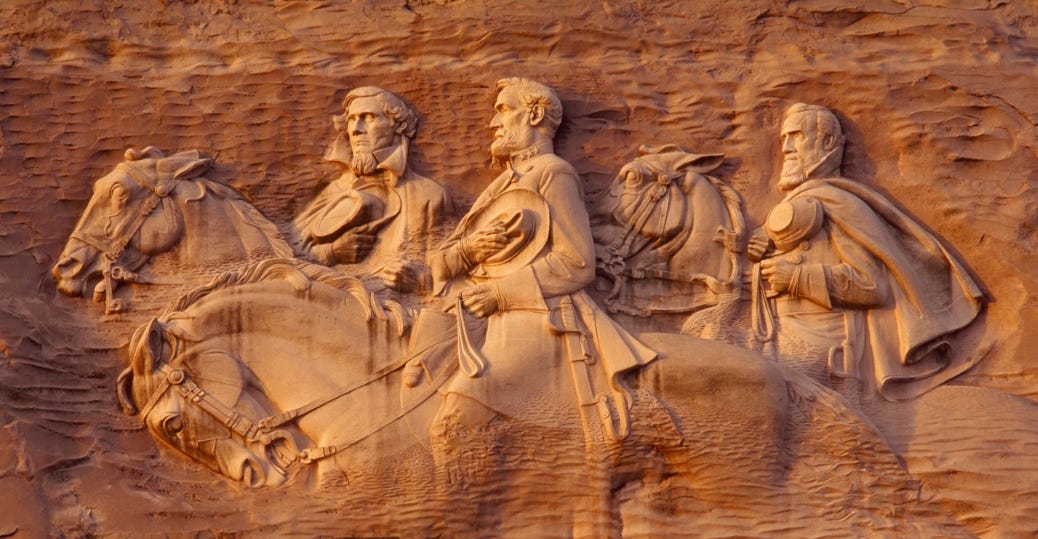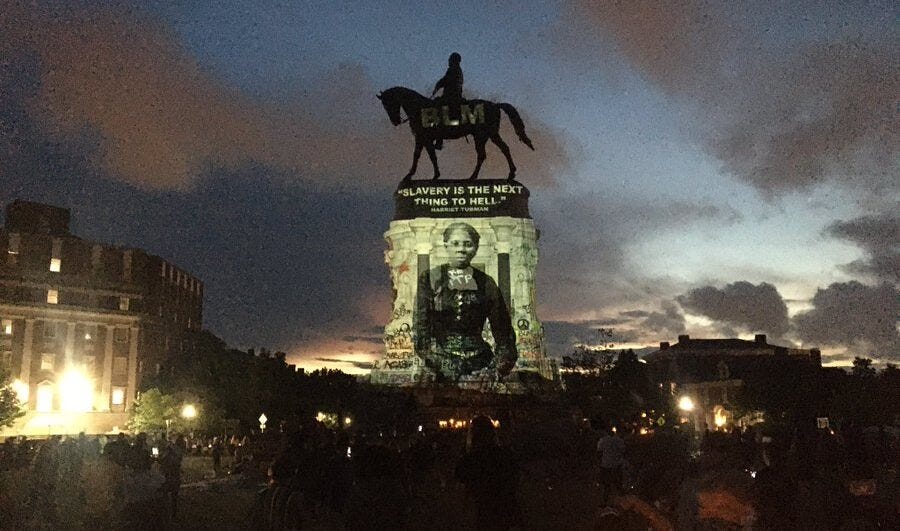The Sons of Confederate Veterans has been issued a permit by the Stone Mountain Memorial Association [SMMA] to gather at Stone Mountain, just outside of Atlanta, to celebrate Confederate Memorial Day at the end of April. It is a reminder that this site is still viewed by many as a Confederate shrine. Back in January I wrote about the challenges that the SMMA faces in developing plans to reimagine the site.
The SMMA is now soliciting proposals from cultural and museum exhibition design and interpretive planning teams for the development of an Interpretive Plan for Memorial Hall in Stone Mountain Park. This is a welcome development, but it involves a significant number of challenges that will need to be addressed if a meaningful transformation of the site is to take place.
First and foremost it is crucial to understand that but for the logistical challenges and current political climate in Georgia, this sculpture would likely have already been removed. This is not a matter of simply throwing a few hundred pounds of explosives at Gutzon Borglum’s massive relief sculpture. The lack of political will and other legislative roadblocks have ensured that for the foreseeable future the sculpture will remain in place.
This fact reinforces the need for a radical transformation of both the landscape around the sculpture and especially the exhibit space inside the museum and visitor center.
The land in between the museum and the mountain needs to be reimagined. It currently contains seating areas representing each state of the Confederacy, which contain interpretive panels highlighting the Lost Cause narrative of the Confederacy and the Civil War. This needs to be removed, though parts of it could be reintegrated later into an exhibit space focused on how the site has been interpreted.
I would like to see this space used by sculptors and other artists. The space could contain new monuments and other works of art that place the sculpture in conversation. A stage could be used for interpretive dance and other performances that help to transform the meaning of the site in ways that empower people.
We saw this at the foot of the Robert E. Lee monument in Richmond in 2020-21. The base was used for a wide range of artistic performances, including interpretive dance that empowered people who were long rendered invisible by the monument’s very presence.
At night the monument was used to project images onto it that helped to transform the monument’s meaning. This could easily be done at Stone Mountain.
The ways in which Confederate monuments and memorials have transformed communities like Richmond and Charlottesville, Virginia cannot be ignored at Stone Mountain. The site must acknowledge the ways in which these monuments have become intertwined in the events of the past few years, including the police murder of George Floyd in 2020, the “Unite the Right” rally in Charlottesville in 2017, and the murder of the “Charleston Nine” in 2015.
It goes without saying that the museum and exhibition space also needs to be transformed. We need to start by acknowledging that the primary story that needs to be told is not that of the Civil War, though it is certainly important. As I have pointed out time and time again, monuments and statues tell us much more about the individuals and organizations behind them and the times in which they lived than they do about their subject. This is important to acknowledge at Stone Mountain.
The story of Stone Mountain and the sculpture specifically is one that begins at the height of the Jim Crow era with the revival of the Ku Klux Klan on site in 1915 and the United Daughters of the Confederacy’s involvement in securing the location for Borglum’s vision. The narrative can help to contextualize not just Stone Mountain, but the vast majority of Confederate monuments that were dedicated during the turn of the twentieth century and through the 1930s.
It’s a story that continues well into the second half of the twentieth century, beginning with the steps taken to complete the memorial after it languished for decades. The very establishment of the SMMA and legislation passed in 1958 to complete the sculpture must be understood in the context of a growing civil rights movement and states rights response to Brown v. Board of Ed. in 1954.
One can interpret the completion of a memorial honoring Robert E. Lee, Jefferson Davis, and Stonewall Jackson as a form of “massive resistance” against civil rights, in ways that are not entirely unlike the renaming of schools and other public spaces after Confederate leaders during this period.
This is a Georgia, a regional, and a national story.
Significant resources need to be set aside for education, especially at the k-12 level. While Georgia students are the most likely visitors, efforts should be made to attract students from all over the country and even beyond to confront this history and the many questions and challenges it raises for us today.
As important as this history is, the interpretive space and surrounding landscape needs to be utilized in ways that go beyond history entirely. These spaces can also be used for community conversations about a wide range of current issues that either directly or indirectly connect to this history. This will ensure that the site remains relevant moving forward.
This, in admittedly broad strokes, is what needs to happen at Stone Mountain. There has been little attempt to do serious contextualization in museum settings, apart from the recent news that the city of Richmond plans on transferring ownership of the Lee monument other Confederate monuments to the Black History Museum, which will work in partnership with the Valentine Museum and other institutions to properly interpret them for the public.
The only question—and it’s an important one—is whether the SMMA and the institutions that submit proposals have the courage to tackle the history and legacy of Stone Mountain. We are in the midst of a debate over the teaching of American history that has seen a number of states pass legislation that bans the teaching of certain subjects, all of which connect to the history of Stone Mountain.
Thankfully, we have examples of the kind of courage and commitment necessary to highlight difficult and complex history, most notably at EJI’s National Memorial for Peace and Justice in Montgomery, Alabama.
Having read the SMMA’s Request for Proposals I am confident that we are headed in the right direction.
Let me know what you think in the comments below. What, if anything, would you add to this outline?







In Memento Park in Hungary, authorities created an open air museum for statues and monuments from the communist era. Perhaps they should do the same in Stone Mountain for all the Confederate monuments and statues that were torn down during the last few years.
Glad you referenced EJI, the Equal Justice Initiative. I hope the SMMA will consult them, as they should have some good advice. There must also be the will to change the state law “ which mandates that Stone Mountain Park be maintained as a monument to the Confederacy”. https://www.ajc.com/neighborhoods/dekalb/permit-okd-for-confederate-memorial-day-event-at-stone-mountain-park/E2L3PERLR5FABENVI5GSS3JWUQ/